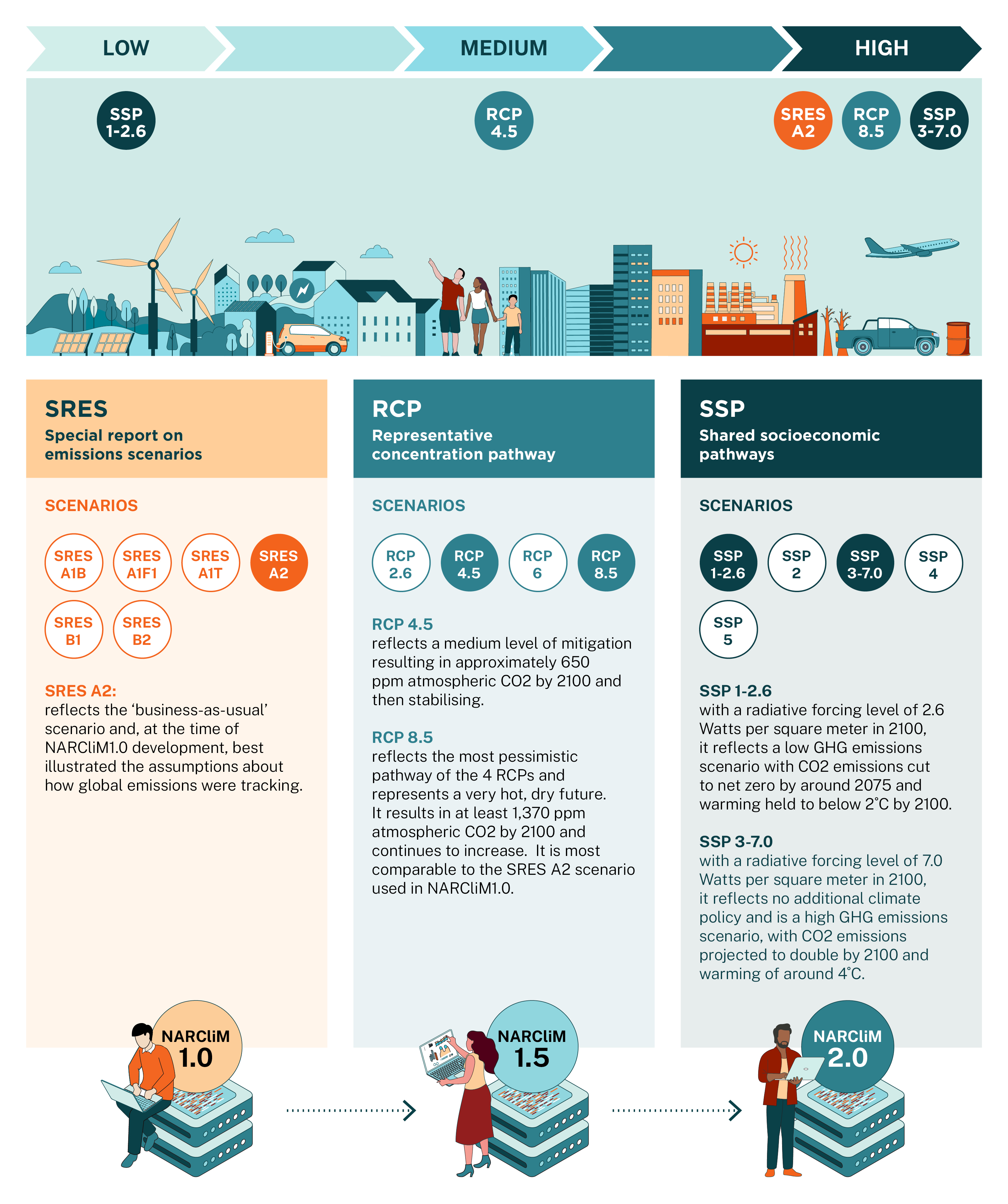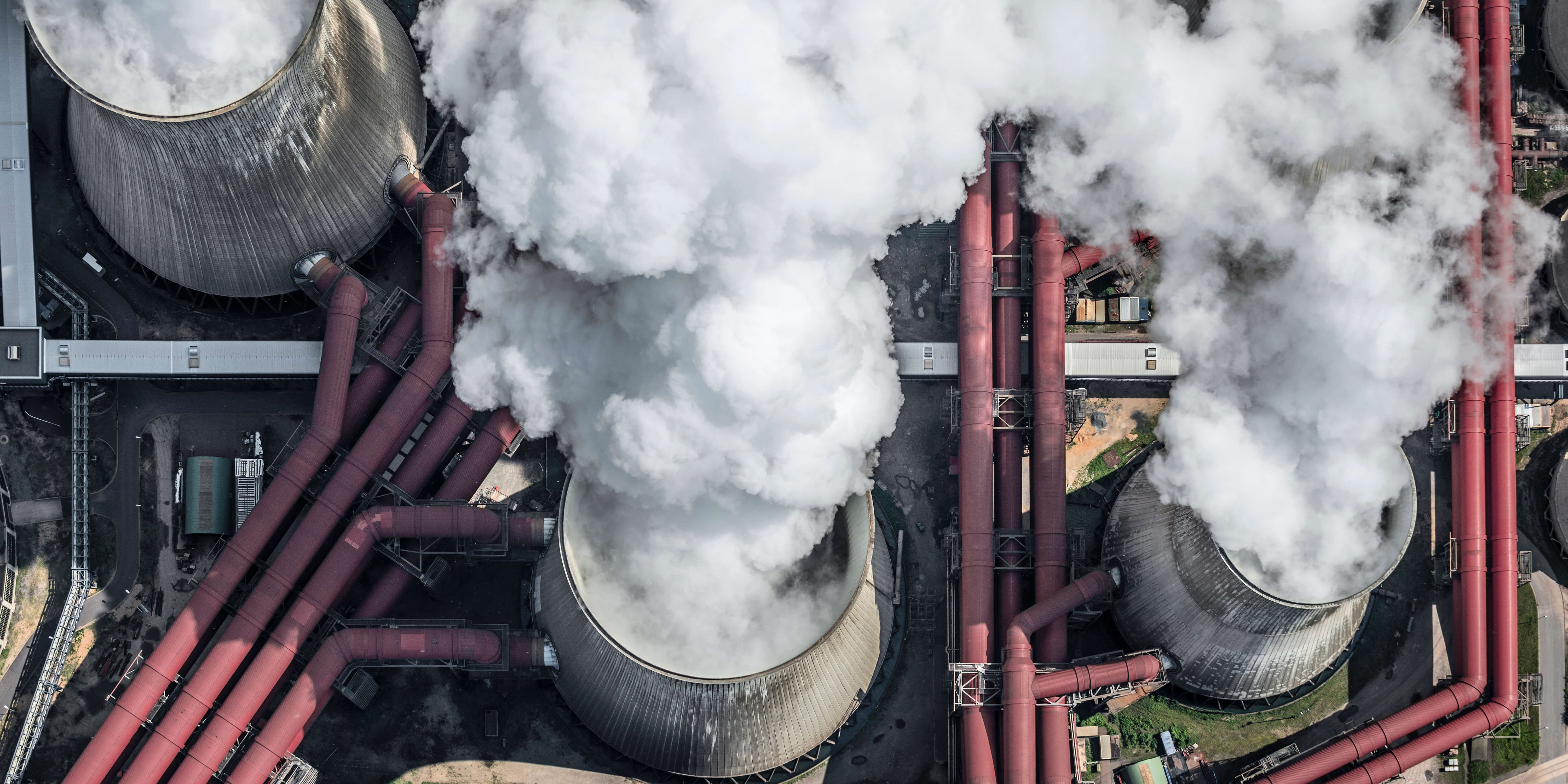Key points
- Greenhouse gas emissions scenarios are used to investigate how climate patterns may change at different points in the future.
- NARCliM adopts the same emissions scenarios as used by the Intergovernmental Panel on Climate Change (IPCC) in their comprehensive assessment reports on the state of climate change.
- Each generation of NARCliM uses the latest available emissions scenarios, which ensures that the projections are based on the best available information.
About emissions scenarios
Future climate patterns could look different depending on the concentration of greenhouse gases in the atmosphere or the actions we take that increase or decrease greenhouse gas emissions.
Many factors influence the amount of greenhouse gases in the atmosphere, such as:
- fossil fuel versus renewable energy use
- population growth
- technological advancements
- human behaviour
- policy support for systems transformation.
These different factors make it impossible to know exactly what greenhouse gas concentrations will be in the future (see Limitations and appropriate use).
Because of this, NARCliM uses a range of emissions scenarios to understand different future climates. The scenarios used by NARCliM are from the Coupled Model Intercomparison Project (CMIP), which is endorsed by the IPCC. CMIP scenarios are based on the latest available science and consultation with world-leading experts across multiple climate related disciplines. The scenarios also form the basis of the IPCC’s Assessment Reports.
CMIP emissions scenarios are iterative. New types of scenarios are produced to reflect the latest available science and integrate more recent observations of emissions, land use changes and other important influences (such as volcanic eruptions) on the climate system. All scenarios are considered to be plausible futures for the planet at the time of development.
Types of emissions scenarios
To date, emissions scenarios associated with the CMIP effort and IPCC follow 2 main approaches – storyline and concentration pathways.
The storyline approach makes assumptions on how society will behave and develop in terms of the factors that influence emissions. Storylines then estimate the world’s future emissions and how these will affect the climate. The storyline approach is used for both the IPCC’s Special Report on Emissions Scenarios (SRES) and the Shared Socioeconomic Pathways (SSPs).
The concentration pathways approach works backwards from an assumed concentration of greenhouse gases in the atmosphere to describe the steps that society might take to reach that level, such as developing and implementing climate policy. The concentration pathways approach is used for the Representative Concentration Pathways (RCPs).
SSPs and RCPs complement each other. The RCPs describe different trajectories for greenhouse gas concentrations, including the mitigation targets associated with them, such as the level of policy support. The SSPs describe the level and type of action needed to reduce emissions for different trajectories.
Storyline (SRES and SSP) = Actions → Projected future emissions level
Concentration pathway (RCP) = Potential future emissions level → Actions likely to lead to that level
Emissions scenarios used by NARCliM
NARCliM adopts the same emissions scenario types as used in the IPCC’s comprehensive assessment reports on the state of climate change. As the science advances, new emissions scenarios are developed. This is reflected in the evolving design of NARCliM generations, ensuring the projections are based on the best available information.
For each NARCliM generation, the scenarios were chosen by carefully considering:
- the amount of data (computational load)
- computational time and costs related to the number of chosen global climate model (GCM) and regional climate model combinations
- the spatial resolution of the domains
- producing climate data that meet the needs of NARCliM end-users.

NARCliM2.0 – SSPs
The SSPs build on the RCPs by adding 5 storyline pathways based on socioeconomic factors that may change, which all lead to different future climates to 2100. Factors include population and economic growth, education, urbanisation, land use and land cover change, and the rate of technological development. The level of radiative forcing (the change in energy balance in Earth's atmosphere) is listed after the SSP – for example, SSP1-2.6 is the SSP1 scenario with a radiative forcing of 2.6W/m–2.
NARCliM2.0 uses 2 storyline scenarios – SSP1-2.6 and SSP3-7.0:
- SSP1-2.6 to reflect a low-emissions future. This results in a projected global mean surface air temperature increase of 1.3–2.4°C, with a best estimate of 1.8°C (2.6 W/m² by the year 2100).
- SSP3-7.0 to reflect a high-emissions future. This results in a projected global mean surface air temperature increase of 2.8–4.6°C, with a best estimate of 3.6°C. (7 W/m² by the year 2100).
These projected increases are for the 2081–2100 period compared to the 1850 to 1900 pre industrial reference period, according to the CMIP6 GCMs.
NARCliM1.5 – RCPs
An RCP is a greenhouse gas concentration pathway, not a trajectory of emissions and socioeconomic factors. RCPs describe different pathways based on the level of greenhouse gases, air pollutants and land use, per year to 2099. Unlike SRES, some RCPs consider mitigation and adaptation strategies in their pathways. In its Fifth Assessment Report (AR5), the IPCC adopted 4 RCPs describing different future climates with different levels of atmospheric carbon dioxide, measured in parts per million. At the time, these RCPs were all considered possible depending on the amount of greenhouse gases emitted in the next few decades.
NARCliM1.5 uses 2 concentration pathways – RCP4.5 and RCP8.5:
- RCP4.5 reflects a scenario with an intermediate level of mitigation (for example, through emissions reduction and carbon sequestration). This results in a projected warming of 1.1–2.6°C, with a best estimate of 1.8°C.
- RCP8.5 reflects a scenario of continued emissions increase. This results in a projected warming of 2.6–4.8°C, with a best estimate of 3.7°C.
Using these 2 scenarios increases the range of plausible future climates from NARCliM1.0. Globally, RCP8.5 leads to a slightly warmer future than SRES A2 (used in NARCliM1.0) and RCP4.5 leads to less warming than SRES A2.
NARCliM1.0 – SRES
The IPCC’s SRES assume no additional climate policy initiatives, or current or future measures to limit emissions. Each SRES storyline assumes a different direction for future developments of the factors that influence emissions. From these assumptions, each storyline differs and results in very different end scenarios.
NARCliM1.0 simulated a single SRES – SRES A2. This scenario was chosen because it closely resembled the greenhouse gas emissions trajectory at the time of developing NARCliM1.0 projections. It describes rapid population growth but slower economic growth and technological changes than other SRES storylines. The resulting warming of this scenario is between 2.0°C and 5.4°C (with a best estimate of 3.4°C) for the 2090–2099 period compared to a 1980–1999 baseline.
Scenarios of future climate change across NARCliM generations
While each generation of NARCliM is based on best available climate modelling and emissions scenarios at the time of release, it is important to note that there are significant advancements in the models underpinning NARCliM2.0. This includes improved accuracy and resolution compared to NARCliM1.0.
As an example, the future climate projected for NSW by NARCliM2.0 is drier and hotter than the future climate projected by NARCliM1.0. However, the key trends or patterns across NSW are similar between generations, especially for temperature which is the most robust indicator of climate change.
